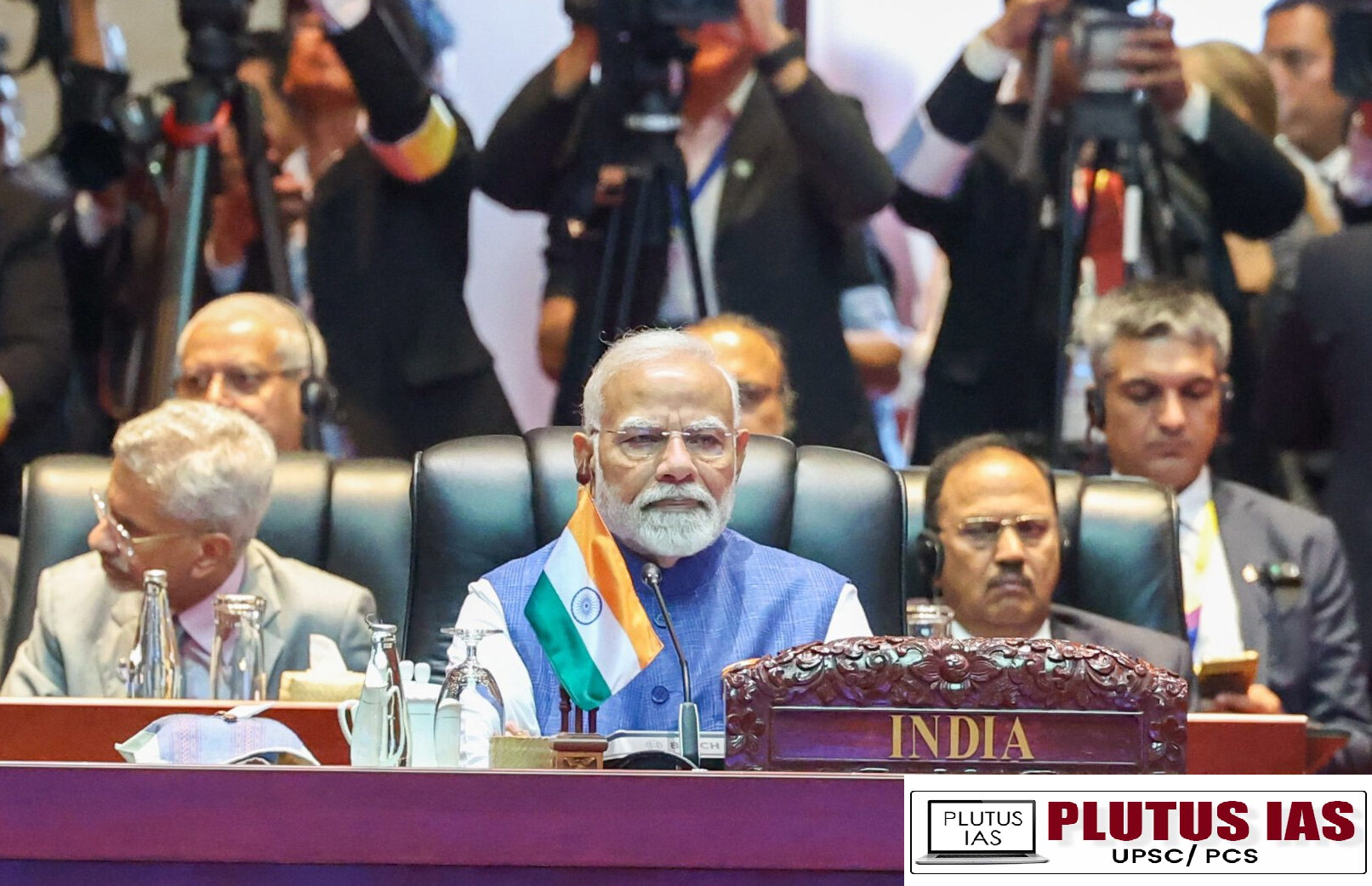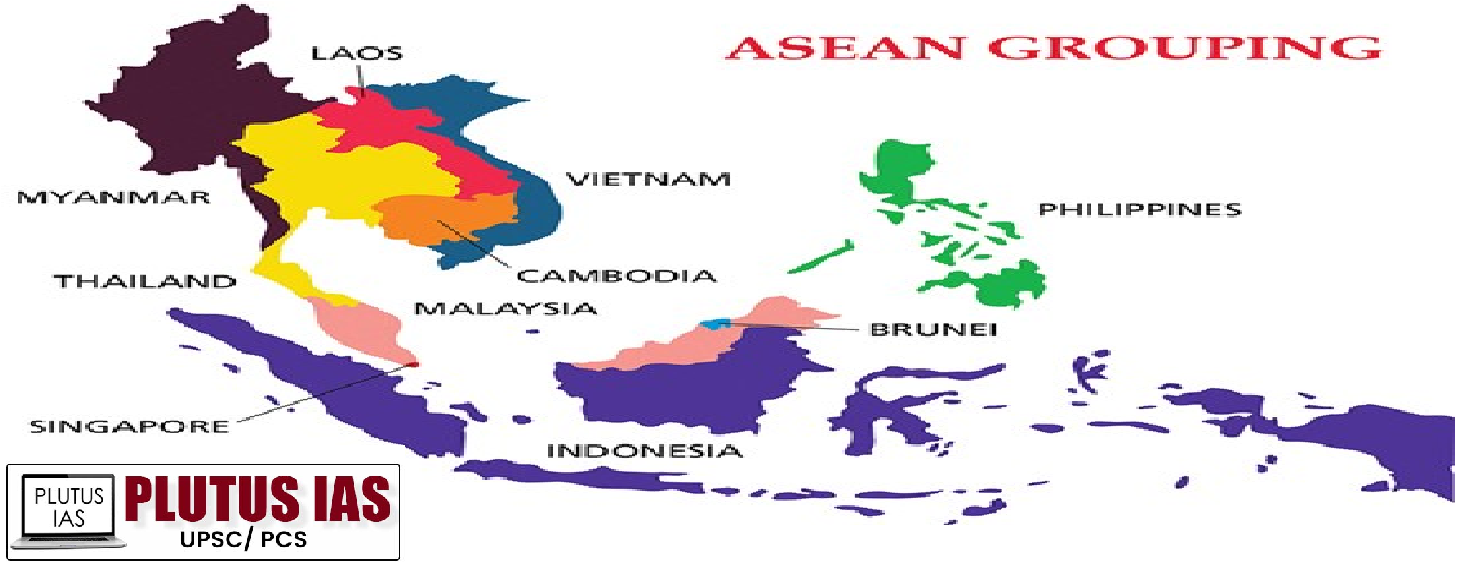14 Oct A Strategic Forum: The Role of the 21st East Asian Summit in Regional Dynamics
SYLLABUS MAPPING:
GS-2- International relations-A Strategic Forum: The Role of the 21st East Asian Summit in Regional Dynamics
FOR PRELIMS:
What is the importance of the East Asian Summit in improving cooperation among countries in East Asia? Mention some key issues discussed in recent summits.
FOR MAINS:
Evaluate the role of the East Asian Summit in enhancing regional security and economic cooperation. How does it address the challenges posed by geopolitical tensions in the region?
Why In the News?
The 19th East Asia Summit on 11 October 2024 in Vientiane, Lao PDR, the Prime Minister highlighted ASEAN’s crucial role in the Indo-Pacific regional framework. The Prime Minister highlighted ASEAN’s crucial role in the Indo-Pacific regional framework and its alignment with India’s Indo-Pacific Vision and Quad cooperation. He emphasized that India’s engagement in the summit is vital to its Act East Policy, advocating for a free, open, and inclusive Indo-Pacific as essential for regional peace and development. The Prime Minister pointed out the shared perspectives between India’s Indo-Pacific Ocean Initiative and the ASEAN Outlook on Indo-Pacific, urging a development-focused approach over one based on expansionism.

Key Facts:
1. Established: 2005
2. Members: 18 countries (10 ASEAN + Australia, China, India, Japan, New Zealand, Russia, South Korea, USA)
3. Objectives: Promote dialogue on political, security, and economic issues; enhance regional stability; address global challenges.
4. Chairmanship: Rotates annually among member countries.
5. Working Groups: Focus on specific areas like finance, security, and disaster management.
6. Economic Impact: Members account for ~60% of global GDP and ~50% of global trade.
7. Security Issues: Addresses maritime security, counter-terrorism, and nuclear non-proliferation.
8. Climate Change Focus: Emphasizes sustainable development and environmental cooperation.
9. Indo-Pacific Focus: Highlights strategic dynamics in the Indo-Pacific region.
Background on the East Asian Summit (EAS):
1. Regional Security: Tensions in the South China Sea and the Korean Peninsula were prominent topics, with calls for peaceful resolutions and adherence to international laws.
2. Economic Recovery: Discussions highlighted the need for coordinated efforts to recover from the COVID-19 pandemic, including vaccine distribution and economic support for the most affected countries.
3. Climate Change: Environmental issues were also addressed, with participants emphasizing commitments to combat climate change and promote sustainable development.
4. Geopolitical Dynamics: The summit reflected ongoing geopolitical rivalries, particularly between the U.S. and China, influencing discussions around trade and security alliances.
5. Health Security: Beyond COVID-19, the summit emphasized strengthening health systems and improving pandemic preparedness to mitigate future health crises.
6. Trade Agreements: Discussions often include the Regional Comprehensive Economic Partnership (RCEP) and other trade initiatives aimed at enhancing economic integration and reducing trade barriers among member states.
7. Technology and Cybersecurity: The increasing importance of technology in international relations led to dialogues about cybersecurity threats, digital economy collaboration, and the need for regulations to protect data privacy.
8. Maritime Cooperation: Issues related to maritime security were underscored, with discussions around ensuring freedom of navigation and the lawful use of sea resources, particularly in contested waters.
9. Counter-Terrorism: Member states frequently reaffirm their commitment to combating terrorism and violent extremism through enhanced cooperation and intelligence sharing.
10. Humanitarian Issues: The summit has also addressed regional humanitarian challenges, including responses to natural disasters and support for refugee crises in various parts of East Asia.
East Asian Summit Members:
ASEAN Members (10):
Brunei
Cambodia
Indonesia
Laos
Malaysia
Myanmar
Philippines
Singapore
Thailand
Vietnam
Additional Members (8):
Australia
China
India
Japan
New Zealand
Russia
South Korea
United States

Significance of the East Asian Summit :
1. Regional Cooperation: Facilitates dialogue and collaboration among diverse countries in East Asia and the Indo-Pacific.
2. ASEAN Centrality: Reinforces ASEAN’s pivotal role in shaping regional security and economic frameworks.
3. Addressing Security Challenges: Provides a platform for discussing pressing security issues, including maritime security, terrorism, and nuclear non-proliferation.
4. Economic Integration: Promotes economic cooperation and trade among member states, enhancing regional prosperity.
5. Inclusive Dialogue: Encourages participation from major powers and smaller nations, fostering a balanced approach to regional governance.
6. Rules-Based Order: Advocates for a free, open, and inclusive Indo-Pacific region based on international law and norms.
7. Sustainable Development: Addresses global challenges such as climate change and disaster management, promoting sustainable practices.
8. Geopolitical Stability: Contributes to regional stability amid evolving geopolitical dynamics, particularly in the context of U.S.-China relations.
9. Cultural Exchange: Fosters cultural understanding and people-to-people connections among member states.
Significance of India in the East Asian Summit:
1. Counter China’s Influence: ASEAN’s strategic location makes it a critical partner for balancing China’s growing influence in the region.
2. Trade and Investment: In 2021-2022, trade between India and ASEAN stood at around $110 billion. ASEAN countries are also a significant destination for Indian investments.
3. Indo-Pacific Region: ASEAN is central to India’s Indo-Pacific strategy, which seeks to promote a free, open, and rules-based order in the region.
India’s Act East Policy places ASEAN at its core to enhance connectivity, maritime cooperation, and economic engagement.
4. Counter-Terrorism: India collaborates with ASEAN on counter-terrorism, transnational crime, and cybersecurity initiatives. These efforts are crucial in maintaining regional security.
5. Connectivity and Infrastructure: Initiatives such as the India -Myanmar-Thailand Trilateral Highway and the Kaladan Multimodal Transit Transport Project aim to improve physical connectivity between India and ASEAN, promoting trade and economic integration.
6. ASEAN-led Mechanisms: India is part of key ASEAN-led platforms like the;
7. Cultural Diplomacy: Fosters cultural exchange and people-to-people connections, enhancing mutual understanding and cooperation.
8. Sustainable Development: Advocates for sustainable practices and climate change initiatives, aligning with global environmental goals.
Significance of BOP, UNCLOS, China Threat, Maritime Peace, Regional Power, and Indo-Pacific Economic Dynamics:
1. Balance of Power (BOP): A stable balance of power stops any one country from dominating the region, helping maintain peace and encouraging countries to form alliances, especially to counter China’s influence.
2. United Nations Convention on the Law of the Sea (UNCLOS): This provides rules for maritime rights, ensuring fair access to ocean resources and helping to peacefully resolve disputes over sea boundaries, which supports regional stability.
3. China Threat: China’s strong actions in the South China Sea raise concerns for neighbouring countries about their territorial integrity. This can lead to collaboration among nations to enhance security against perceived threats.
4. Maritime Peace: Emphasizes the need for security initiatives to ensure safe navigation in international waters and encourages dialogue to prevent conflicts over maritime disputes.
5. Regional Power: Countries like India, Japan, and Australia are important for maintaining stability and countering threats, especially from China. Strong regional powers can lead efforts in economic cooperation and security.
6. Indo-Pacific Economic Dynamics: The Indo-Pacific region is crucial for global economic growth, offering opportunities for trade and investment. It promotes economic integration and strengthens regional supply chains, making countries less dependent on external powers.
Irritants of the 21st East Asia Summit:
1. South China Sea Tensions: Disputes over territorial claims continued to be a major point of contention, particularly regarding China’s assertive actions in the region.
2. North Korea’s Nuclear Activities: Ongoing missile tests and nuclear development by North Korea raised concerns, leading to calls for stronger diplomatic efforts for denuclearization.
3. U.S.-China Rivalry: The growing strategic competition between the U.S. and China created friction, with member states balancing their relations amid pressures from both sides.
4. Economic Recovery Disparities: Uneven recovery from the COVID-19 pandemic caused tensions, especially regarding vaccine access and economic support for less developed nations.
5. Cybersecurity Issues: Increasing cybersecurity threats and state-sponsored cyberattacks prompted discussions about the need for improved international cooperation.
6. Climate Change Commitments: Disagreements arose over responsibilities for addressing climate change, particularly between developed and developing nations.
7. Trade Barriers: Protectionist measures and trade tensions created friction, with calls for open markets and fair trade practices.
8. Human Rights Concerns: Discussions on human rights violations in certain countries led to diplomatic disagreements on how to address these issues effectively.
Way forward:
1. Strengthen trade relations through RCEP and bilateral agreements to enhance economic growth.
2. Enhance cooperation on security issues, including counter-terrorism and maritime security, to maintain stability in the Indo-Pacific.
3. Promote cultural exchanges and people-to-people connections through educational initiatives and tourism.
4. Jointly work towards achieving the UN Sustainable Development Goals (SDGs), focusing on climate action and poverty alleviation.
5. Invest in regional infrastructure projects to facilitate trade and economic integration.
6. Collaborate in technology and digital transformation to drive economic growth and resilience.
7. Strengthen disaster management cooperation to improve regional preparedness for natural disasters.
8. Maintain regular high-level dialogues and participate in regional multilateral forums to address emerging challenges.
Conclusion:
The East Asia Summit highlighted the vital role of ASEAN in the Indo-Pacific framework and reinforced India’s commitment to regional stability and cooperation. As member states confront challenges such as security tensions, economic disparities, and climate change, the summit provides a crucial platform for dialogue and collaboration. By focusing on trade relations, security cooperation, and sustainable development, the summit paves the way for a more integrated and resilient Indo-Pacific region, promoting peace and prosperity for all nations involved.
Download plutus ias current affairs eng med 14th Oct 2024
Prelims Question:
Q.Which of the following statements accurately reflects the significance of ASEAN in the context of the Indo-Pacific framework as highlighted in the 19th East Asia Summit?
A. ASEAN’s role is primarily economic, focusing only on trade relations among its member states.
B. ASEAN is central to India’s Act East Policy and aligns with India’s Indo-Pacific Vision, emphasizing regional stability and cooperation.
C. ASEAN has limited influence in the Indo-Pacific, mainly serving as a platform for cultural exchanges.
D. ASEAN operates independently of major powers like the U.S. and China in the Indo-Pacific context.
Answer: B
Mains Question:
Q. Analyze the implications of India’s Act East Policy as discussed during the 21st East Asian Summit. In what ways does India’s engagement with ASEAN countries contribute to regional stability and economic integration?
(250 words, 15 marks)




No Comments